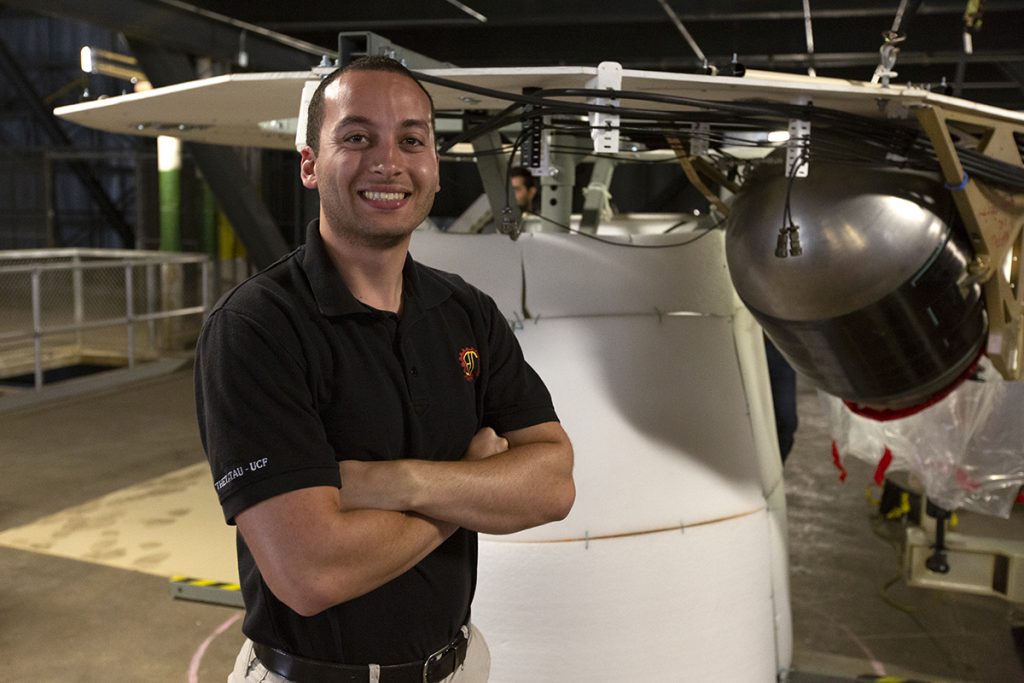Robert Cook, Christopher Di Taranto and Sherild Rivera Melendez aren’t old enough to have seen the first release of blockbuster movies “Jurassic Park” or “The Lion King.” If you combine their years on Earth, that total barely surpasses retirement age. But the Kennedy Space Center engineers already are making significant contributions at the Florida spaceport, as they are among a group of talented young workers who played a major role in the first demonstration of a critical new tool.
On April 4, the avionics handling tool for NASA’s Space Launch System was put to the test inside Kennedy’s Vehicle Assembly Building. The goal was to show that avionics boxes, including the Inertial Navigation and Control Assembly and flight batteries, could be successfully mounted into the SLS rocket’s upper stage — called the Interim Cryogenic Propulsion Stage, or ICPS — safely, and with low risk of damaging a closely located hydrazine tank. The actual avionics handling tool was used for installation into an ICPS section mockup.
“I think there was a great deal of success,” said Cook, a 24-year-old launch vehicle engineer with Millennium Engineering and Integration who designed the accurately scaled mockup from inception to completion. “The driving factors were reducing required time to complete the actions, pointing out clearance issues and identifying refinements we can make in the process. We were able to do all of that.”

Tool Test
An installation test prior to the demonstration took about four hours. Official time on the demo: 56 minutes.
“It’s a new program and there are a lot of new people here,” said Di Taranto, 23, who graduated from the University of Central Florida. “But we’re getting valuable experience; we’re learning pretty quickly so we can excel in the future.”
As a member of the mechanical structures engineering team on the Jacobs Test and Operations Contract at Kennedy, Di Taranto was in charge of resolving a non-conformance issue that arose in February when an alignment bolt became galled into a key insert during testing. He effectively coordinated with the chief engineers and successfully led technicians in removing the insert and reinstalling a new one in an extremely timely manner.
Rivera Melendez, 25, is a former Pathways intern and University of Puerto Rico-Mayaguez graduate who became a full-time NASA flight systems engineer in September 2018. She coordinated multiple human factors teams, focusing on life cycle reviews and impact risks during installation of the avionics.
“It was great exposure — perfect for getting into the familiarization with the flight hardware and operations,” she said.
Larry Budnick, a senior staff engineer with TOSC Spaceflight Processing, helped oversee the avionics tool demonstration and was instrumental in its planning. He praised the efforts of the many civil servants and contractors from Kennedy and NASA’s Marshall Space Flight Center who contributed to its success. Cook, Di Taranto and Rivera Melendez definitely made that list.
“They’re sharp young people,” said Budnick, who has 30 years of experience in aerospace. “It’s impressive how adaptive they are to these processes.”
Historic Mission
Practice and testing with the avionics handling tool and mockup will continue until it is time to complete the exercise for real. That will take place in high bay 3, inside the VAB, just weeks before NASA’s SLS rocket and uncrewed Orion spacecraft lift off on Exploration Mission-1 (EM-1) from Launch Pad 39B at Kennedy. EM-1 will send Orion on a three-week test flight thousands of miles beyond the Moon and back.
The historic mission is not lost on the young engineers.
“As a kid, seeing rockets go up from the other side of the state, and now, actually being a part of it is kind of surreal,” said Cook, an Embry-Riddle Aeronautical University grad who grew up in St. Petersburg. “It’s a dream job to work with rockets at Kennedy Space Center.”
For Rivera Melendez, the dream started as a young girl in Puerto Rico.
“I’ve always wanted to come here, but when you’re little, it feels so far away,” she said. “Now it’s like I’m putting my own little grain of sand into something that is going to be a part of history.”
